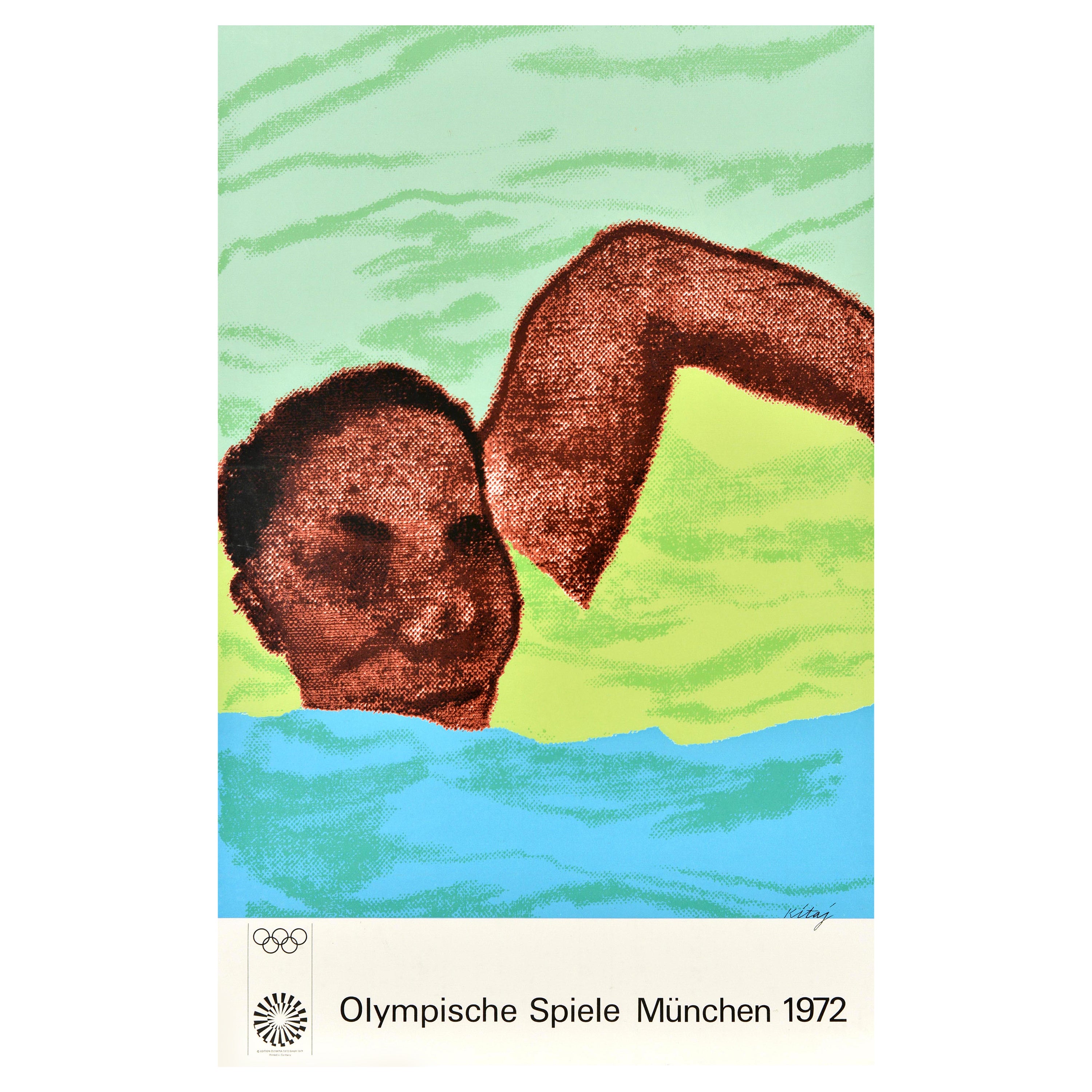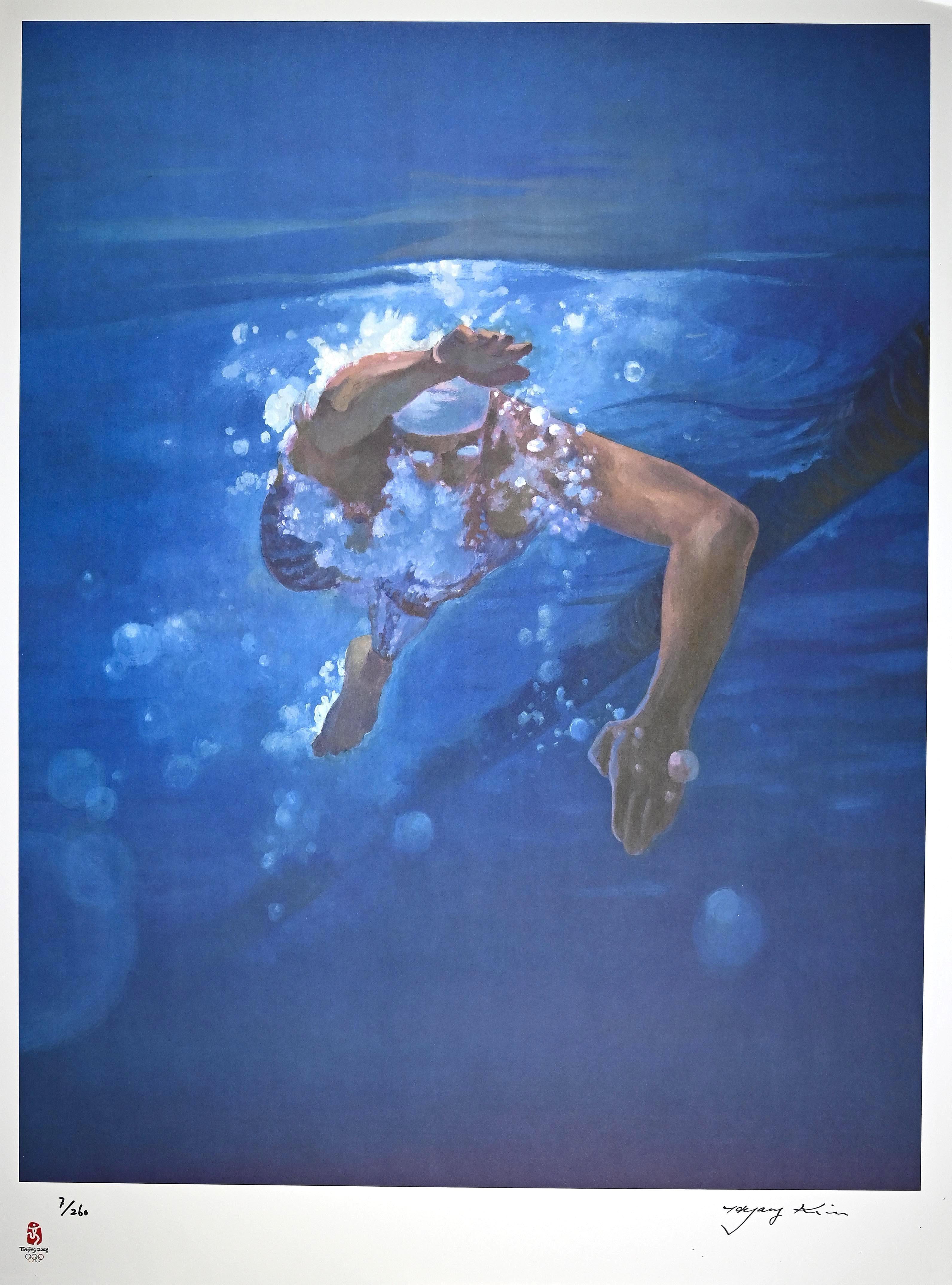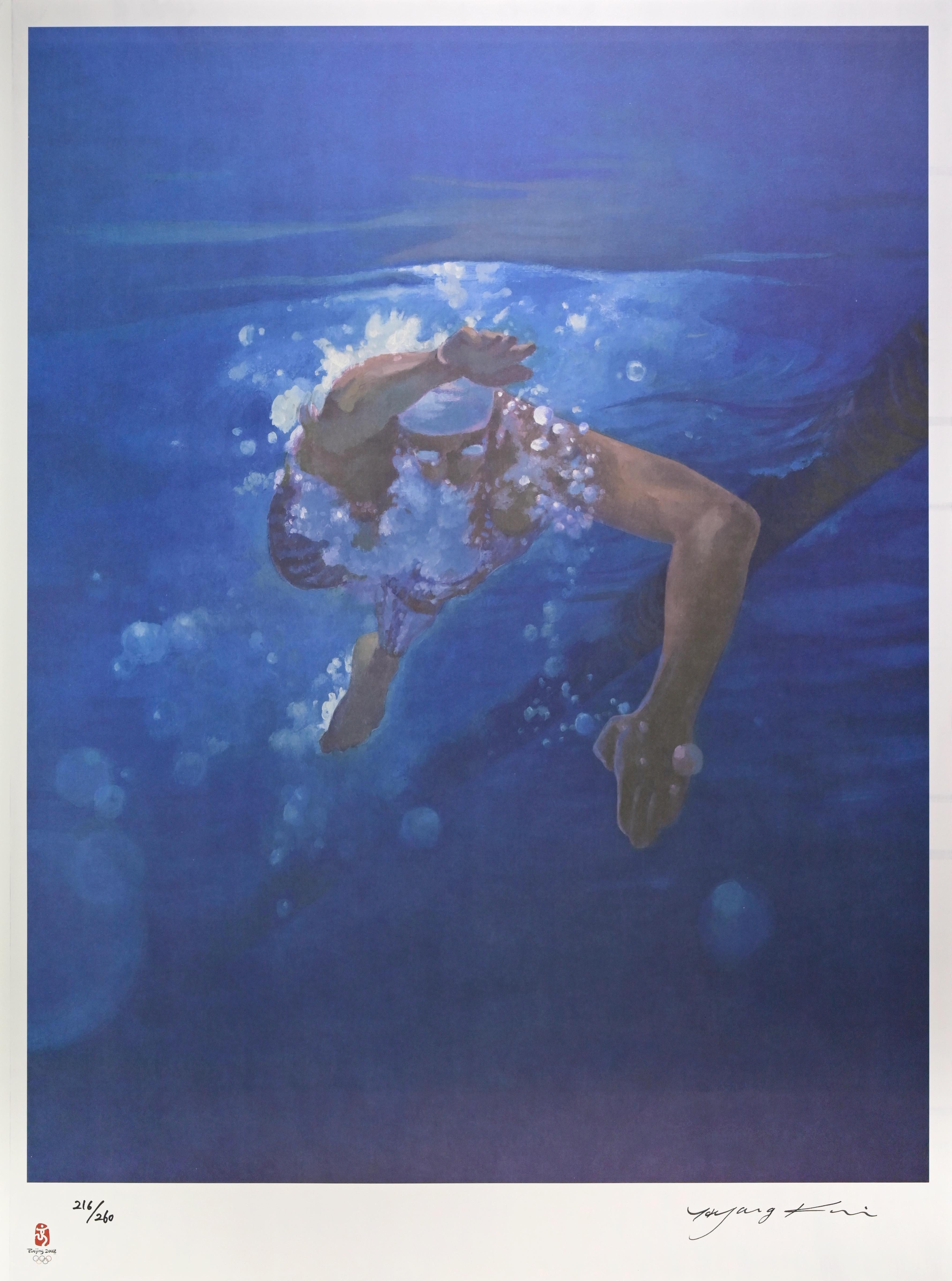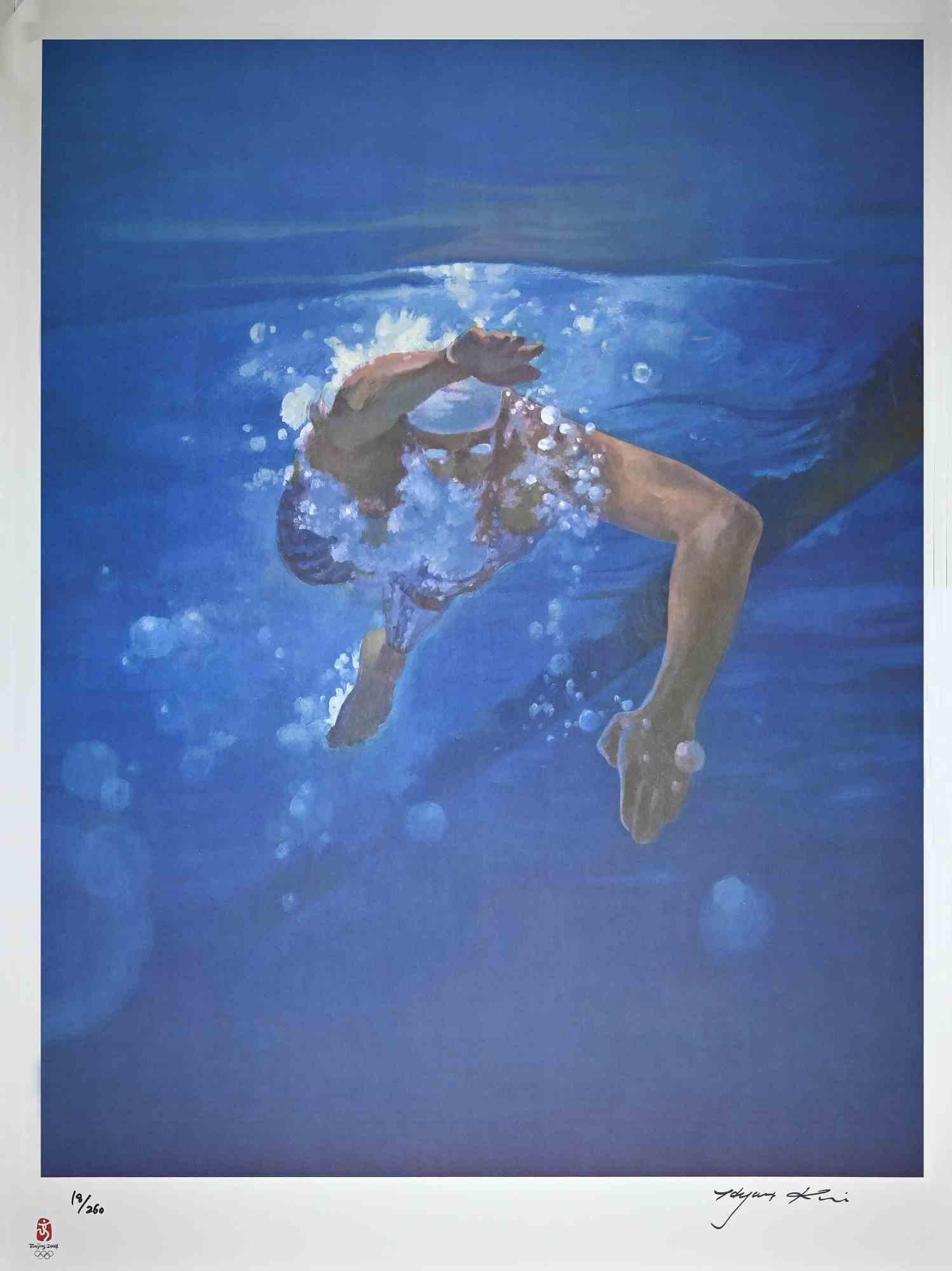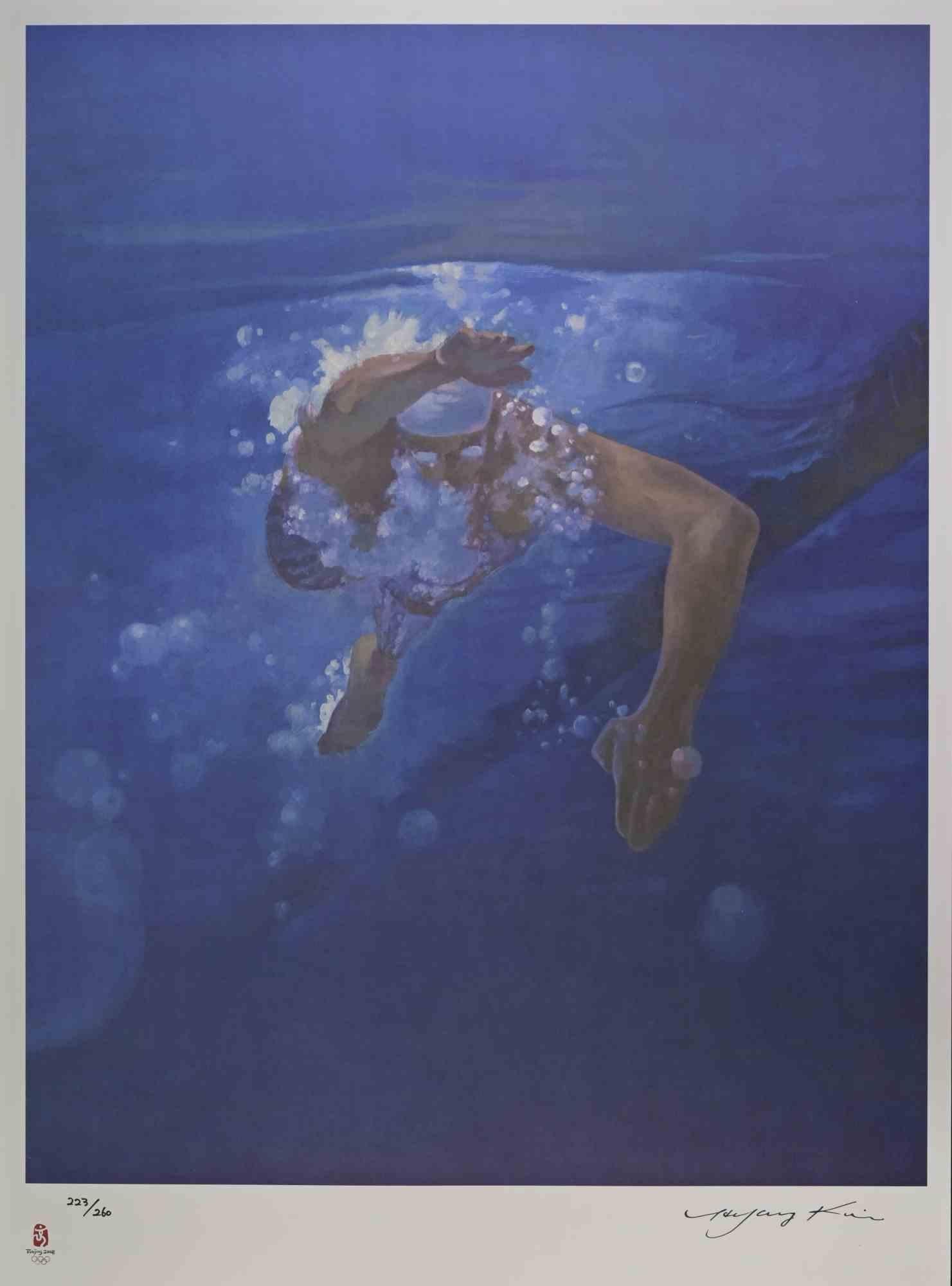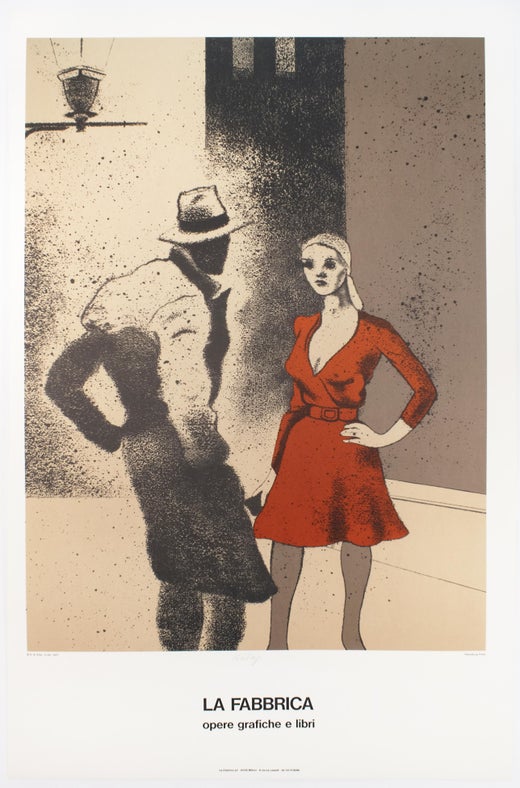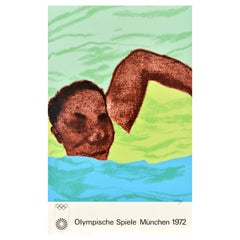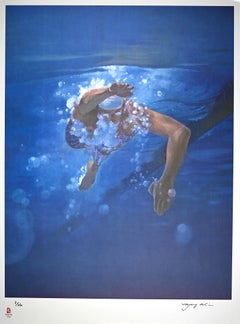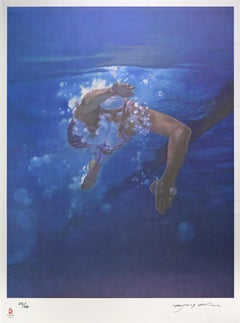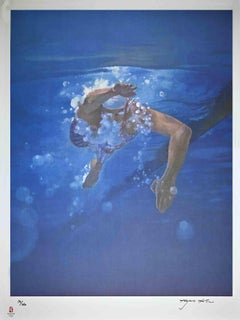Items Similar to Swimmer - Screenprint (Olympic Games Munich 1972)
Want more images or videos?
Request additional images or videos from the seller
1 of 9
Ronald Brooks KitajSwimmer - Screenprint (Olympic Games Munich 1972)1972
1972
$235
£179.37
€200
CA$331.41
A$364.11
CHF 190.29
MX$4,342.34
NOK 2,409.55
SEK 2,244.70
DKK 1,524.38
About the Item
Ronard Brooks KITAJ
Swimmer
Screen print
Signature printed in the plate
On heavy paper 101 x 64 cm (c. 40 x 26 inch)
Made for the Olympic Games in Munich, 1972
Excellent condition
- Creator:Ronald Brooks Kitaj (1932-2007, American)
- Creation Year:1972
- Dimensions:Height: 39.77 in (101 cm)Width: 25.2 in (64 cm)
- Medium:
- Movement & Style:
- Period:
- Condition:
- Gallery Location:Paris, FR
- Reference Number:1stDibs: LU46433142073
Ronald Brooks Kitaj
Born in Cleveland, Ohio in 1932, R.B. (Ronald Brooks) Kitaj is considered a key figure in European and American contemporary painting. While his work has been considered controversial, he is regarded as a master draftsman with a commitment to figurative art. His highly personal paintings and drawings reflect his deep interest in history; cultural, social and political ideologies; and issues of identity. Among his various honors are election to the American Academy of Arts and Letters in 1982, and election to the Royal Academy in 1985 (the first American since John Singer Sargent to receive this honor.) Numerous retrospective exhibitions of his work include shows at the Hirshhorn Museum in Washington, D.C.; The Jewish Museum, Berlin; The Jewish Museum, London; and the Hamburger Kunsthalle in Germany. Raised in Cleveland, Ohio, and Troy, New York, Kitaj joined the Merchant Marines in 1949.
In 1950, between sailings, he attended classes at the Cooper Union for the Advancement of Science and Art in New York. He went on to study drawing at the Academy of Fine Art in Vienna, Austria. Kitaj moved to Oxford, England in 1957, and enrolled at The Ruskin School of Drawing and Fine Art, University of Oxford. In 1959, Kitaj was accepted into Royal College of Art, London, where he befriended classmate David Hockney. Upon graduation from the RCA, Kitaj signed with Marlborough Fine Art, London, where he had his first solo exhibition in 1963. His art career began in earnest, and he found critical acclaim alongside commercial success. A second solo show followed at Marlborough Gallery, New York, in 1965, and he sold “The Ohio Gang” to The Museum of Modern Art. In 1969, Kitaj taught for a year at the University of California, Los Angeles. In 1976, he coined the term “School of London” in an essay he wrote as curator of the polemical exhibition, “The Human Clay,” at the Hayward Gallery, London. The term, though loose, continues to define a group of stylistically diverse artists, including Kitaj, who were working in London at that time focusing on figural representation. In 1981, he spent a year in Paris, France, where he focused on drawing and use of pastel. In 1994, the Tate Gallery, London, organized a major retrospective of Kitaj’s work. Hostile and personal attacks from some critics led to what Kitaj referred to as the “Tate War.” The exhibition subsequently traveled to the Los Angeles County Museum of Art and the Metropolitan Museum of Art, New York. Kitaj moved to Los Angeles, California, and continued to exhibit with Marlborough Fine Art and the Marlborough Gallery, New York. In 2001 the National Gallery London organized a solo exhibition of paintings: “R.B. Kitaj In the Aura of Cezanne and Other Masters.” Kitaj focused on his “late style” in his Yellow Studio in Westwood and died in 2007. His gift of his archive to the UCLA Library Special Collections was celebrated with exhibitions at the Skirball Cultural Center and UCLA’s Young Research Library.
About the Seller
4.9
Platinum Seller
Premium sellers with a 4.7+ rating and 24-hour response times
Established in 2010
1stDibs seller since 2016
3,790 sales on 1stDibs
Typical response time: <1 hour
- ShippingRetrieving quote...Shipping from: Paris, France
- Return Policy
More From This Seller
View AllPool Diver - Lithograph (Olympic Games Munich 1972)
By David Hockney
Located in Paris, IDF
David HOCKNEY
Pool Diver, 1972
Original lithograph
Signature printed in the plate
On paper 101 x 64 cm (c. 40 x 26 inch)
Made for the Olympic Games in Munich, 1972
REFERENCES : Bri...
Category
1970s American Modern Figurative Prints
Materials
Lithograph
Tribute to Cezanne : The Bather - Original handsigned lithograph
By Jules Cavailles
Located in Paris, IDF
Jules CAVAILLES
Tribute to Cezanne : The Bather, 1966
Original lithograph
Handsigned in pencil
On Rives vellum 37 x 28 cm (c. 15 x 11 inch)
Excell...
Category
1960s Modern Figurative Prints
Materials
Lithograph
$188 Sale Price
20% Off
Lying Woman - Original vintage lithograph poster, Maeght 1966
By Francis Bacon
Located in Paris, IDF
Francis BACON (after)
Lying Woman
Original vintage lithograph poster
On heavy paper
71 x 45 cm (c. 28 x 18 inch)
This lithograph was created for the arti...
Category
1960s Modern Figurative Prints
Materials
Lithograph
Nude on Blue Backgroung - Original Lithograph Poster (Maeght, 1974)
By Walasse Ting
Located in Paris, IDF
Walasse Ting
Nude on Blue Backgroung, 1974
Original Lithograph Poster
Printed signature in the plate
On heavy paper 63 x 50 cm (c. 25 x 20 in)
Created for the artist exhibition in M...
Category
1970s American Modern Nude Prints
Materials
Lithograph
Man at the Beach - Original Handsigned Screen Print /60ex
By Jean Coulot
Located in Paris, IDF
Jean COULOT (1928 - 2010)
Man at the Beach
Original screen print
Handsigned in pencil
Numbered / 60 ex
On vellum 22 x 20 cm (c. 9 x 8 in)
Excellent condition
Category
Late 20th Century Modern Figurative Prints
Materials
Screen
Colors on Podium - Lithograph (Olympic Games Munich 1972)
By Richard Smith
Located in Paris, IDF
Richard SMITH
Colors on Podium
Lithograph
Signature printed in the plate
On heavy paper 101 x 64 cm (c. 40 x 26 inch)
Made for the Olympic Games in Munich, 1972
Excellent condition
Category
1970s Modern Abstract Prints
Materials
Lithograph
You May Also Like
Original Vintage Sport Poster Munich Summer Olympics 1972 Swimming RB Kitaj
By Ronald Brooks Kitaj
Located in London, GB
Original vintage sports poster for the 1972 Summer Olympics in Munich - Olympische Spiele Munchen - designed by the painter and printmaker Kitaj (Ronald Brooks Kitaj; 1932-2007) depi...
Category
Vintage 1970s German Posters
Materials
Paper
The Swimmer - Lithograph by Kim Hyang - 2008
By Kim Hyang
Located in Roma, IT
The Swimmer is an original lithograph realized in 2008 by Kim Hyang
Hand signed and numbered, edition 7/260.
Official stamp of the Olympic Organising Committee lower left.
Excellent...
Category
Early 2000s Contemporary Figurative Prints
Materials
Lithograph
Swimmer - Lithograph by Kim Hyang - 2008
By Kim Hyang
Located in Roma, IT
Swimmer is a contemporary artwork realized by Kim Hyang in 2008.
Mixed colored lithograph.
Hand signed and numbered on the lower margin.
Realized in occasion of the Olympic Games...
Category
Early 2000s Contemporary Figurative Prints
Materials
Lithograph
Swimmer - Lithograph by Kim Hyang - 2008
By Kim Hyang
Located in Roma, IT
Swimmer is an original lithograph realized by Kim Hyang.
This artwork is from the portfolio The Unique Collection for the Olympic Fine Arts 2008 presented during the Olympic Games a...
Category
Early 2000s Contemporary Figurative Prints
Materials
Lithograph
Swimmer - Lithograph by Kim Hyang - 2008
By Kim Hyang
Located in Roma, IT
Swimmer is a contemporary artwork realized by Kim Hyang in 2008.
Mixed colored lithograph.
Hand signed and numbered on the lower margin.
Realized in occasion of the Olympic Games...
Category
Early 2000s Contemporary Figurative Prints
Materials
Lithograph
Swimmer - Lithograph by Kim Hyang - 2008
By Kim Hyang
Located in Roma, IT
Swimmer is a contemporary artwork realized by Kim Hyang in 2008
Mixed colored lithograph
Hand signed and numbered on the lower margin
Realized in occasion of the Olympic Games in...
Category
Early 2000s Contemporary Figurative Prints
Materials
Lithograph
More Ways To Browse
Toyohara Kunichika Original
Typography Vintage Poster Design
Ukiyo Samurai
Ulysses Dali
Vintage Drug Posters
Vintage Pinup Girls Art
Vintage Print Girl Bird
W H Howell
Wax Doll
Wharton Esherick Art
Whistler Fumette
William Blake Original
William Hogarth Beauty
Yoko Ono Lithograph Harold Town
Zamy Steynovitz Serigraph
Zeno Giglietti
18th Century Shoe Buckle
1960 1970 Posters
